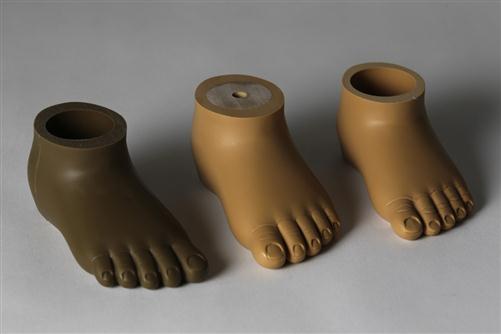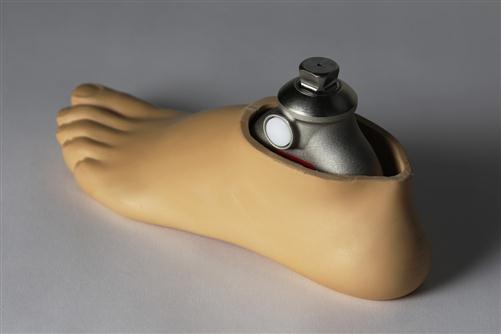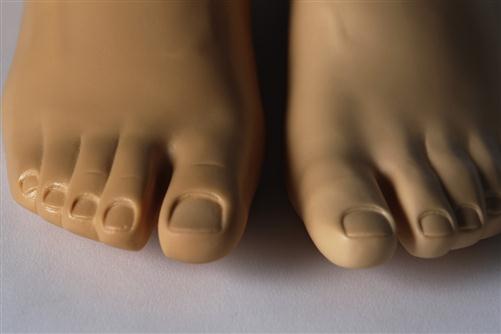Understanding Prosthetic Feet
Kevin Carroll, John Rheinstein and Elicia Pollard
Learning Objectives
On completion of this chapter, the reader will be able to:
1. Define the Medicare functional levels.
2. Explain key factors analyzed when prescribing a prosthetic foot.
3. Define the fundamental characteristics of the different types of prosthetic feet.
4. Formulate a prescription recommendation for a prosthetic foot based on the patient’s needs.
Just as every person is unique, every person with an amputation presents a different set of characteristics that should be considered when selecting a prosthetic foot. This selection should be made carefully as safety, performance, and patient satisfaction can be impacted if the foot is not well matched to the patient.1 To make an effective selection among the multitude of choices offered by prosthetic foot manufacturers and to succeed in matching the right foot to the right recipient, it is important to thoroughly consider each individual’s current and potential abilities and needs. The rehabilitation team should carefully review a patient’s medical and prosthetic history while keeping in mind the performance features, specifications, and appearance of available feet. Past research studies offered data concerning foot performance and patient preferences, but studies have not yet provided pathways to successful foot selection based on clinical evidence.2–4
The aim of providing a prosthetic foot is to maximize every patient’s rehabilitation potential so that they may return to their daily activities and work at a level comparable to their peers. Ideally, the function of a prosthetic foot should match that of an anatomical human foot.5 It should offer shock absorption, compliance to uneven terrain, push-off, and shortening during the appropriate points in the gait cycle, all in a lightweight, low-maintenance package. In reality, no prosthetic foot available today matches the human foot in all these characteristics. The final choice is always a compromise, as no single prosthetic foot performs optimally for all activities and conditions. The most appropriate foot is one that best serves the user’s unique needs at the time of selection.
Once a specific foot design is selected it must be ordered to meet the specific weight and activity level of each person. If patients experience physical or lifestyle changes, the foot should be replaced to match their new functional needs. For example, a weight gain of 20 or more pounds or substantial increase in activity or loads carried may result in the catastrophic failure of the structural element of a foot. All the parts of a prosthetic system, especially feet, should be checked regularly for wear and tear and replaced immediately if any cracks or other signs of structural failure occur. It is difficult to predict the useful life span of a foot because of the wide range of users and the way they are used.
Factors in selecting a prosthetic foot
When working with a patient to design an appropriate prosthesis, the rehabilitation team (physiatrist, surgeon, primary care physician, physical therapist, and prosthetist) should assess and consider a number of factors that influence component selection. In addition, explaining the function and features to the user and why a foot was selected can enhance their satisfaction.
Functional Level
• Medicare guidelines describe functional levels into which all persons with lower-limb amputation fall and are widely accepted by most payers.6 This classification system determines the medical necessity for components such as feet and other additions to the prosthesis and is based on the patient’s current and potential functional abilities
Medicare policy states, “A lower limb prosthesis is covered when the patient: (1) Will reach or maintain a defined functional state within a reasonable period of time; and (2) is motivated to ambulate.” Clinical assessments of patient rehabilitation potential must be based on the following classification levels:
Note: Persons with bilateral amputation are not strictly bound by the functional level classification requirement.
Potential functional ability is based on the reasonable expectations of the prosthetist, and treating physician, considering factors including, but not limited to the following:
Ideally, the rehabilitation team examines and interviews the patient and reaches a consensus as to the potential functional level each patient is most likely to achieve. The key word in reaching such a decision is “potential,” which challenges the team to predict future outcomes based on past performance and other unknowns. This decision has real implications for patients as it determines what type of foot they will receive. Therefore, if the rehabilitation team believes that a person currently performing at K2 level will at some future date achieve K3 category, the patient should receive a K3-level prosthesis immediately. Not only will this allow the person to work toward achieving the K3 performance with an appropriate foot, but it will save cost over the long run by eliminating the need to purchase two different feet. In addition to the factors mentioned below, the Amputee Mobility Predictor instrument, designed to measure ambulatory potential of lower-limb amputees, can also help to determine future potential.7
Activities of Daily Living and Work Requirements
No single foot can meet a person’s needs in all situations. By determining the most frequent and important activities a balance of performance features can be achieved. For example, someone who works in an office and who also plays golf on weekends should be provided with a multiaxial ankle to accommodate uneven terrain.
Patient’s Weight
Sizes and strengths are available for patients ranging from a baby to those adults weighing more than 500 pounds (Figure 21-1). Weight should be recorded at every patient encounter to insure that a foot is still appropriately matched to the patient. The assumption that an extremely heavy patient cannot be fitted with a prosthesis is no longer true. Because a growing population of patients is overweight, manufacturers are offering prosthetic feet for heavier patients. A prosthetic foot expected to support heavier weights must be specially crafted for increased strength and durability; consequently, the prosthesis itself is larger and heavier because of the additional material included in the foot, pylon, and socket.
Obesity makes prosthetic fitting more difficult; however, the results achieved by overweight people can be very inspirational. Even patients weighting more than 300 pounds should not give up hope. Although initially confined to a nursing home bed, rehabilitation teams that work with overweight patients can fit them with a prosthesis, assist them with standing, begin therapy, and within just a few months have the same bedridden patients walking in and out of the prosthetist’s office on their own. It is not uncommon for functional K1-level patients to progress to K2 level with appropriate care and therapy. Patients are often deconditioned from the illnesses that precipitated their amputation and can make great strides as long as they are motivated.
Amputation Level and Residual Limb Characteristics
Foot selection can bear directly on the health of the person’s residual limb. Ground reaction forces that are transmitted through a person’s body can be damaging to the person’s residual limb, knee, hip, or back. Choosing a foot with compliant heel action can reduce these impact forces. The foot and pylon may also offer vertical shock absorption features, which reduce impact on the residual limb. In general, short or painful residual limbs are fit with feet that are softer to attenuate ground force transmission through the prosthesis. To benefit from feet that store and return energy, a user must walk with a minimum velocity to load the foot so that energy can be returned. If this is not possible because of physical restrictions in strength, range of motion, or balance, a lower-functional-level foot should be provided.
Comorbidities
The deflection dynamics of a foot can have an effect on the health and well-being of a person’s joints. Excessive toe stiffness can cause hyperextension of the knee. The contralateral limb should also be taken into consideration as too soft of a prosthetic toe can cause increased impact on the sound side.
Environmental Stresses and Durability
People exposed to extreme environments need a foot that will not deteriorate under those conditions. If conditions are very harsh, a separate prosthesis may be required. Any foot that is not properly maintained or not dried after getting wet can fail prematurely.
Shoe Choices (Heel Heights and Shoe Shape)
A heel height-adjustable foot (Figure 21-2) can make a significant difference for someone who wants to wear high heels or switch between different heel-height shoes, depending on the formality of the occasion or work requirements.
Although a heel-height adjustable foot can flatten for barefoot walking, the prosthetic foot shell will wear out quickly if it is used without a shoe. Seasonal aspects are also important; providing a split between the big toe and its neighbor may not seem important in the fall or winter, but is very noticeable in the summer when the user wants to wear thong sandals (Figure 21-3).
< div class='tao-gold-member'>
Stay updated, free articles. Join our Telegram channel

Full access? Get Clinical Tree











